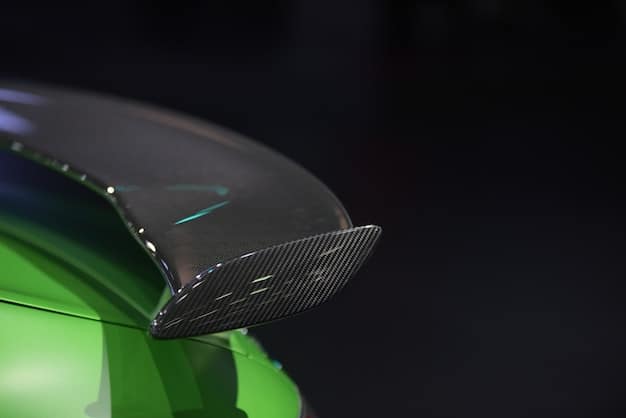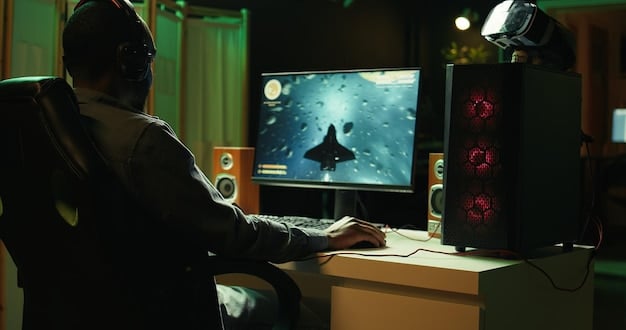RTX 5090 Upgrade: Is $2000 Worth It for PC Gamers in 2025?

For PC gamers in 2025, a RTX 5090 upgrade costing $2000 presents a nuanced value proposition, heavily dependent on individual gaming habits, existing hardware, and the specific performance gains offered by the new architecture. While it promises unparalleled performance, the investment’s worth hinges on future game demands and the necessity for such extreme graphical power.
The dawn of 2025 brings with it the highly anticipated release of NVIDIA’s next-generation flagship GPU, the RTX 5090, rumored to carry a hefty price tag of around $2000. For many PC gamers, this immediately sparks a crucial question: is this significant investment truly worth it? As technology advances at a relentless pace, discerning the genuine value of such a premium upgrade becomes paramount, balancing the allure of cutting-edge performance with practical considerations of cost and necessity.
Unveiling the RTX 5090: Anticipated Specs and Performance
The NVIDIA RTX 5090, poised to be the apex of GPU technology in late 2024 or early 2025, is rumored to bring substantial architectural advancements over its predecessors. Industry analysts and leaked specifications suggest a leap in CUDA core density, clock speeds, and memory bandwidth, aiming to redefine ultra-high-fidelity gaming. These enhancements are not merely incremental; they represent a concerted effort to push the boundaries of what’s graphically possible, particularly in resolutions beyond 4K.
NVIDIA’s Blackwell architecture, expected to power the 50 series, promises significant efficiency gains alongside raw power. This means not only higher frame rates but also potentially better power consumption relative to performance, a crucial factor for enthusiasts building high-end systems. Early benchmarks, though speculative, hint at performance uplifts that could range from 50% to 100% over the current RTX 4090 in certain synthetic tests and demanding gaming scenarios. Yet, the real-world impact on everyday gaming experiences remains the ultimate determinant of its worth. Gamers are looking for tangible improvements that translate directly into smoother gameplay and more immersive visuals, especially in the most graphically intensive titles.
Architectural Innovations and Core Improvements
The Blackwell architecture is expected to introduce several key innovations. These include rumored improvements to the Tensor Cores for AI applications and DLSS, as well as enhancements to the RT Cores for more realistic ray tracing. These core improvements are critical for future-proofing a high-end GPU purchase, ensuring it can handle the evolving demands of game engines and rendering techniques effectively.
- 🔥 Increased CUDA Core Count: Significant boost in parallel processing power.
- ⚡ Enhanced Clock Speeds: Higher operational frequencies for faster computations.
- 💾 Next-Gen Memory Interface: Wider buses and faster VRAM (potentially GDDR7) for massive bandwidth.
- 💡 Improved Ray Tracing Cores: More efficient and higher-fidelity ray tracing performance.
Projected Performance Benchmarks
While official benchmarks are still under wraps, industry analysis based on historical performance trends and rumored specifications indicates impressive gains. Expect the RTX 5090 to dominate 4K gaming, offering smooth 120+ FPS in most titles with ray tracing enabled, and potentially pushing into 8K gaming as a more viable option. The performance leap will likely be most pronounced in games that fully leverage the new architectural features, such as advanced ray reconstruction and DLSS iterations.
Beyond raw frame rates, the 5090 is also expected to excel in professional workloads, including 3D rendering, video editing, and AI development, making it a versatile powerhouse. This additional capability might sweeten the deal for content creators who also happen to be avid gamers. However, for a purely gaming-focused individual, these non-gaming benefits might not factor into the “worth it” equation as much.
In essence, the RTX 5090 isn’t just about raw power; it’s about a holistic improvement across all facets of graphical computation. This comprehensive upgrade strategy aims to provide a definitive, no-compromise gaming experience that justifies its premium positioning in the market. The blend of architectural efficiency and brute force computational capabilities sets the stage for a new standard in PC gaming hardware.
The $2000 Price Tag: A Deep Dive into Value
A $2000 graphics card is a significant financial commitment, placing the RTX 5090 firmly in the ultra-enthusiast segment of the market. Understanding the true value of such an investment requires a critical look beyond raw performance numbers. It involves assessing the longevity of the card, its impact on the overall gaming experience, and comparing it to alternative hardware strategies. Is it a luxury for early adopters, or a necessity for those seeking the absolute pinnacle of gaming performance?
Market Positioning and Pricing Justification
NVIDIA has historically positioned its x090 series as the undisputed kings of frames, often with a price tag to match. The $2000 rumored price for the 5090 reflects not only the advanced fabrication processes and cutting-edge R&D but also NVIDIA’s dominance in the high-end GPU market. This pricing strategy targets users who prioritize absolute performance above all else, often content creators, professional streamers, and competitive gamers who demand every possible frame and pixel of fidelity. The justification for this cost often lies in the “halo product” effect, where the 5090 sets the bar for what’s possible, influencing the perception and prestige of the entire product line.
For most gamers, a $2000 GPU represents a substantial portion, if not the entirety, of their PC budget. This necessitates a careful consideration of whether the marginal gains over cheaper alternatives (such as the expected RTX 5080 or even a discounted RTX 4090) warrant such an expenditure. The diminishing returns curve for performance-per-dollar becomes very steep at this price point, meaning each additional percentage of performance costs significantly more. Therefore, the perception of value becomes highly subjective, depending heavily on an individual’s financial capacity and their hunger for top-tier performance.
Longevity and Future-Proofing Potential
One of the primary arguments for investing in a high-end GPU like the RTX 5090 is its potential for future-proofing. By acquiring the most powerful card available, gamers aim to ensure their system remains relevant and capable of running new titles at high settings for many years to come. The substantial performance headroom of a card like the 5090 means it can comfortably handle future game releases, which are inevitably more demanding, without requiring an immediate upgrade.
However, “future-proofing” is a concept with inherent limitations. While the 5090 will undoubtedly offer excellent performance for a foreseeable future, technological advancements in game development (e.g., more complex physics, advanced AI, higher-resolution textures) can quickly make even the most powerful hardware feel less cutting-edge. Furthermore, the rapid evolution of display technology, such as the increasing popularity of 8K monitors and ultra-high refresh rate panels, places ever-greater demands on GPUs. So, while the 5090 offers superior longevity compared to mid-range cards, it’s never an absolute guarantee against obsolescence. The value derived from its longevity depends on how long a gamer feels satisfied with its performance before the itch for the next-gen truly sets in.

Assessing Your Current Gaming Setup: Do You Need It?
Before even considering the RTX 5090, a critical self-assessment of your current PC gaming setup is essential. The question of “worth” is deeply personal and dependent on what you already have, what you play, and what your expectations are. Upgrading to a flagship GPU might be overkill for some, while a game-changer for others. The effectiveness of the 5090 is directly tied to the rest of your system components, meaning that it won’t operate in a vacuum of sheer power.
Current GPU and Usage Scenarios
If you’re currently sporting an RTX 4090, 4080 Super, or even a high-end 30-series card, the leap to a 5090 might offer diminishing returns that aren’t justified by the $2000 price tag. These cards are already incredibly powerful and capable of handling most modern games at 4K resolution with high frame rates, especially with the aid of technologies like DLSS. However, for those with older cards, such as an RTX 20-series or earlier, the performance jump will be monumental, potentially transforming their entire gaming experience.
Consider your primary usage scenarios: Are you aiming for competitive esports at 144Hz 1080p? The 5090 would be significant overkill. Are you seeking to max out graphical settings in the latest AAA titles at 4K 120Hz with full ray tracing? Then the 5090 starts to make a lot more sense. Evaluate the games you play most frequently. If they are graphically undemanding, the immense power of the 5090 might never be fully utilized, making it an extravagant purchase rather than a truly valuable upgrade. The real benefit comes when your current hardware consistently struggles to meet your desired visual fidelity and frame rate targets.
Monitor Resolution and Refresh Rate
The resolution and refresh rate of your monitor are arguably the most crucial factors in determining whether an RTX 5090 upgrade is worth it. A 1080p monitor, even at high refresh rates, simply won’t fully utilize the horsepower of a 5090. The bottleneck will quickly shift from the GPU to the display, rendering much of the card’s potential moot. For such setups, a mid-range card would offer a far better performance-per-dollar ratio.
The 5090 is designed for high-resolution, high-refresh-rate gaming. This primarily means 4K at 120Hz or higher, or potentially 8K gaming. If you own an ultrawide monitor, especially a high-resolution one, the 5090’s increased pixel-pushing power will be highly beneficial. Gamers with existing 4K 144Hz monitors, or those planning to upgrade to one in 2025, will see the most significant and justifiable gains from a move to the 5090. Without a display capable of showcasing its capabilities, a $2000 GPU upgrade is like buying a supercar to drive in a small town with a 30 mph speed limit – impressive, but ultimately underutilized.
- 📺 High-Resolution Displays (4K/8K): Essential to harness the 5090’s power.
- 🚀 High Refresh Rate Monitors (144Hz+): Allows for a smoother, more responsive experience.
- 🎮 Ultrawide Gaming: Significant benefits for immersive, expansive gameplay.
- 💲 Budget Display Considerations: A top-tier GPU often necessitates a top-tier monitor.
CPU and System Integration
A flagship GPU like the RTX 5090 demands a CPU that can keep up. Pairing it with an older or less powerful processor will result in a CPU bottleneck, where the CPU can’t feed data to the GPU fast enough, preventing the 5090 from reaching its full potential. This means that a $2000 GPU upgrade might necessitate a further investment in a top-tier CPU (e.g., an Intel Core i9 or AMD Ryzen 9 from the latest generations) and potentially a new motherboard and RAM to match.
Furthermore, consider your power supply unit (PSU). A card of the 5090’s caliber will likely require a high-wattage PSU (850W-1000W or more) and sufficient cooling solutions within your PC case. A system integration approach is crucial; the 5090 is not just a component, but a central pillar around which an entire high-performance system must be built. Failing to account for these other components can severely limit the perceived “worth” of the GPU upgrade, as you won’t experience its full capabilities due to other system limitations. Always plan for a balanced system to truly justify such a substantial GPU investment.
Beyond Raw Performance: Ray Tracing, DLSS, and AI
While raw frame rates remain a crucial metric for gamers, the value of the RTX 5090 extends far beyond just how many frames per second it can push. NVIDIA’s ecosystem of advanced technologies, particularly ray tracing, DLSS (Deep Learning Super Sampling), and an ever-expanding suite of AI-driven features, are integral to the premium experience offered by their top-tier GPUs. These technologies not only enhance visual fidelity but also provide performance optimizations that can make demanding games playable at high settings. Understanding their impact is key to evaluating the 5090’s overall worth, especially as games increasingly adopt and leverage these innovations.
The Evolution of Ray Tracing
Ray tracing has evolved significantly since its initial introduction, moving from a niche, performance-heavy feature to a more integrated aspect of modern game rendering. The RTX 5090, with its next-generation RT Cores, is expected to offer a substantial leap in ray tracing performance. This means more complex and realistic lighting, reflections, and shadows without the crippling performance penalties seen in earlier generations. For games that fully implement advanced ray tracing effects, the difference in visual quality can be transformative, creating a more immersive and believable world.
For purists who value visual fidelity above all else, the 5090’s superior ray tracing capabilities might be a compelling reason for the upgrade. It’s not just about turning ray tracing “on,” but experiencing it at a level of detail and fluidity that lesser cards simply cannot achieve. This enhanced realism contributes significantly to the overall gaming experience, making worlds feel more vibrant and alive. The continuous improvement in RT Cores ensures that the 5090 will be at the forefront of graphical realism for years to come, pushing boundaries in how games are rendered.
DLSS 4.0 and Beyond
DLSS has become a cornerstone of NVIDIA’s strategy to deliver high performance in demanding scenarios. The RTX 5090 is anticipated to launch with or soon support DLSS 4.0 (or its equivalent next-gen iteration), which promises even greater image quality and performance uplifts than previous versions. DLSS leverages AI to render frames at a lower resolution and then intelligently upscale them to native resolution, often with better results than traditional upscaling methods. This essentially provides “free” performance, allowing gamers to use higher graphical settings, including ray tracing, without a significant frame rate penalty.
- 🧠 AI-Powered Upscaling: Renders at lower resolution, then upscales to native for performance boost.
- 🖼️ Superior Image Quality: Often surpasses native rendering in complex scenes, especially with anti-aliasing.
- ⚡ Frame Generation: Potential for even higher frame rates through AI-generated frames between rendered ones.
- 🎮 Wider Game Adoption: Increasing number of AAA titles support DLSS, adding value to NVIDIA GPUs.
The efficiency and quality of DLSS are particularly relevant for high-resolution gaming (4K, 8K) where raw performance can still struggle. For a $2000 card, the ability of DLSS to unlock maximum visual settings at high frame rates is a significant part of its value proposition. It means that the 5090 isn’t just fast; it’s smart, using AI to deliver an optimized experience. This synergy between raw power and intelligent upscaling makes the 5090 a more complete solution for the cutting edge of PC gaming.
AI Integration and Future Applications
Beyond gaming, the AI capabilities of NVIDIA’s GPUs are becoming increasingly relevant. The next-generation Tensor Cores in the RTX 5090 will undoubtedly enhance its capacity for general-purpose computing and AI tasks. While this might not directly impact all gamers, it does open up possibilities for future gaming applications beyond DLSS, such as more sophisticated in-game AI, dynamic content generation, or even personal AI assistants that integrate with gaming experiences. These broader capabilities add an extra layer of “future-proof” appeal to the card.
For gamers who dabble in content creation, machine learning, or simply want a versatile powerhouse, the AI capabilities of the 5090 enhance its value significantly. It transforms the GPU from a mere display adapter into a supercomputing engine capable of a multitude of complex tasks. This holistic approach to GPU design means that the 5090 is not just a gaming card; it’s a piece of advanced computational hardware ready for the next wave of technological innovation.
Alternative Strategies: The Smart Upgrade Path
While the allure of the RTX 5090 is undeniable, for many PC gamers, a $2000 upgrade isn’t the only, or even the most logical, path to an improved gaming experience. Exploring alternative strategies can reveal more cost-effective ways to achieve satisfactory performance gains, especially if you’re not chasing the absolute bleeding edge. A smart upgrade path often involves balancing performance, budget, and personal gaming priorities, rather than simply aiming for the most expensive component available.
Considering the RTX 5080/5070 or AMD Alternatives
NVIDIA’s product stack typically offers excellent performance from its second and third-tier cards, often at a significantly lower price point. The upcoming RTX 5080 and 5070 are likely to deliver substantial performance improvements over the previous generation, potentially matching or exceeding the performance of the current RTX 4090. These cards could provide a much better performance-per-dollar ratio than the 5090, satisfying the needs of 4K gamers who aim for high frame rates without needing to max out every single graphical slider with ray tracing enabled.
Furthermore, AMD’s RDNA 4 generation of GPUs will be a strong contender. AMD’s cards often offer competitive rasterization performance (traditional graphics rendering) at aggressive price points, and their FidelityFX Super Resolution (FSR) technology provides a viable upscaling alternative to DLSS. Depending on your game library and preferences, an AMD flagship from late 2024 or early 2025 might offer compelling value, especially if raw performance in traditional rendering is your priority and you’re less reliant on NVIDIA-specific features like superior ray tracing performance. Keeping an eye on the competitive landscape is crucial for making an informed decision.
Waiting for Price Drops or Next-Gen
The tech market is notoriously dynamic, and patience can often be rewarded. The initial launch price of the RTX 5090 is likely to represent its peak. Historically, GPU prices tend to stabilize or even fall over time, especially after the initial enthusiast rush subsides. Waiting a few months post-launch could potentially save you a significant amount, moving the card closer to a more palatable price point. This allows you to benefit from the initial reviews and real-world performance data without paying the early adopter premium.
Alternatively, if your current GPU is still performing adequately, waiting for the subsequent generation (e.g., RTX 6000 series) might be a more strategic move. Each new generation brings architectural improvements, and future iterations might offer an even more compelling jump in performance or efficiency, potentially making the 5090 feel less “future-proof” sooner than expected. This strategy is particularly relevant for those who upgrade less frequently and want to maximize the performance gain between generations, rather than making incremental upgrades.

Strategic Component Upgrades and System Optimization
Sometimes, the “upgrade” bottleneck isn’t solely your GPU. Investing $2000 solely in a 5090 might be misplaced if other components of your system are holding back overall performance. Before splurging on a top-tier GPU, consider whether upgrading your CPU, RAM, or even switching to a faster SSD could offer a more noticeable improvement in your specific gaming scenarios. A balanced system often outperforms one with a single ultra-powerful component.
- 💻 CPU Upgrade: Prevents GPU bottleneck, especially in CPU-heavy games.
- 💡 Faster RAM: Can improve overall system responsiveness and minimum frame rates.
- 🚀 NVMe SSD: Reduces load times and can improve texture streaming in open-world games.
- 🌬️ Improved Cooling: Ensures stable performance and longevity of all components.
Furthermore, optimizing your current system through software tweaks, driver updates, and sensible game settings can often squeeze out extra performance without a hardware investment. For instance, sometimes reducing one or two non-essential graphical settings can yield a significant frame rate boost without a noticeable drop in visual quality. A holistic approach that considers the entire system and its optimization can often provide a more satisfying and cost-effective gaming experience than a single, expensive component upgrade.
The Impact of the RTX 5090 on the PC Gaming Ecosystem
The release of a flagship GPU like the RTX 5090 reverberates throughout the entire PC gaming ecosystem, influencing everything from game development to hardware affordability. Its presence not only raises the bar for performance expectations but also sets new challenges and opportunities for both consumers and industry players. Understanding these broader implications helps contextualize the value of such an upgrade, revealing its role beyond individual gaming rigs and into the trends shaping the future of interactive entertainment.
Pushing Game Development Boundaries
Every new generation of powerful GPUs empowers game developers to push the boundaries of visual fidelity and complexity. The RTX 5090 will be no exception. Its immense computational power and advanced features will enable developers to create even more immersive worlds, implement more sophisticated graphical techniques (like path tracing, advanced physics, and AI-driven environments), and support higher resolutions and frame rates as standard. This trickle-down effect eventually benefits all gamers, as innovations first showcased on flagship cards find their way into more accessible hardware over time.
The expectation is that games developed in the late 2020s will increasingly target the capabilities of GPUs like the 5090, making full ray tracing more common and advanced AI features within games more prevalent. For developers, the 5090 acts as a benchmark and a canvas, allowing them to realize their most ambitious artistic and technical visions. This ultimately enriches the gaming landscape for everyone, even if they aren’t directly using a 5090, as these advancements eventually filter down to the masses through optimization and new mid-range hardware.
Influence on Mid-Range and Budget GPUs
While the 5090 itself is a premium product, its impact on the rest of the GPU market is significant. The technology and architectural efficiencies introduced in the flagship model eventually make their way into mid-range and budget-friendly cards. This means that features and performance levels once exclusive to top-tier GPUs become more accessible with subsequent generations. For example, ray tracing performance that required an RTX 3080/4070 might become achievable on an RTX 5060 or 5070 within a few years.
Moreover, the release of a new flagship often drives down the prices of previous generation high-end cards. A used or discounted RTX 4090 or RTX 4080 could become a highly attractive option for gamers looking for near-flagship performance at a reduced cost. This creates a more dynamic market, providing more choices across various price points. Thus, even if you can’t justify the $2000 for a 5090, its existence indirectly benefits you by making powerful older hardware more affordable or by accelerating the trickle-down of advanced features.
Shaping Future Gaming Trends
The capabilities of the RTX 5090 will play a crucial role in shaping future gaming trends. Its immense processing power makes high-fidelity VR an even more compelling prospect, enabling more realistic virtual worlds with less compromise. Similarly, the push towards 8K gaming, while still niche, becomes more viable, potentially establishing a new standard for ultra-high-resolution experiences. Cloud gaming services might also benefit, as the hardware driving these services can be incrementally upgraded with such powerful GPUs, enhancing the streamed experience for subscribers.
Furthermore, the increased AI capabilities foster innovation beyond traditional rendering. Imagine games with truly dynamic AI NPCs that adapt in real-time, or environments that generate procedurally based on player interaction, all leveraging the on-board AI processing power of the GPU. The 5090 isn’t just about playing current games better; it’s about setting the stage for what games will become in the latter half of the decade, driving forward the very definition of what’s possible in interactive entertainment. Its impact extends far beyond your personal gaming rig, influencing the entire industry’s direction and ambition.
| Key Point | Brief Description |
|---|---|
| 🚀 Performance Leap | Expected massive gains over previous generations, especially for 4K/8K gaming and high refresh rates. |
| 💰 $2000 Investment | Premium price targeting enthusiasts; value depends heavily on individual budget and usage needs. |
| 🎯 System Compatibility | Requires high-end CPU, monitor, and PSU to avoid bottlenecks and maximize potential. |
| 💡 Future-Proofing | Offers significant longevity due to advanced tech like next-gen Ray Tracing and DLSS. |
Frequently Asked Questions About the NVIDIA RTX 5090
Industry rumors and analyst projections suggest a significant generational leap. While specific figures are speculative, some predict performance gains ranging from 50% to even 100% in certain demanding titles and synthetic benchmarks, especially at 4K resolution with ray tracing. This would make it considerably faster, establishing a new performance tier.
It’s highly probable if you don’t already have one of the latest high-end CPUs. The RTX 5090’s immense power demands a modern, powerful processor (e.g., Intel Core i9-13900K/14900K or AMD Ryzen 9 7900X3D/7950X3D or newer) to keep it fed with data, especially at lower resolutions or very high frame rates. A CPU bottleneck would limit the GPU’s potential.
Generally, for 1440p or 1080p gaming, the RTX 5090 would be significant overkill for most users. Its full potential is unlocked at 4K resolution and beyond, especially with ultra-high refresh rates and demanding ray tracing. A more cost-effective GPU from the 50-series (like a 5070 or 5080) or even a previous-generation high-end card would likely offer comparable performance at those resolutions.
Historically, NVIDIA’s flagship x090 cards have often commanded a higher price point than AMD’s top-tier offerings, particularly for their superior ray tracing and DLSS performance. While AMD’s RDNA 4 cards may offer competitive performance in traditional rasterization, the RTX 5090 will likely remain at the premium end due to its comprehensive feature set and architectural advancements.
The primary long-term benefits are extended longevity and future-proofing. The 5090 will allow you to play new AAA titles at max settings and high frame rates for many years, delaying the need for another upgrade. Its advanced features like next-gen ray tracing and DLSS ensure it’s ready for evolving game demands, offering a premium experience for an extended period.
Conclusion: The $2000 RTX 5090 – A Calculated Decision for 2025
The debate over whether the RTX 5090 is worth its rumored $2000 price tag for PC gamers in 2025 is not a simple yes or no. It’s a complex equation balancing individual needs, existing hardware, and future gaming aspirations. For the ultra-enthusiast seeking uncompromised performance at 4K or 8K, with every graphical setting maxed out and full ray tracing enabled, the 5090 will undoubtedly deliver an unparalleled experience. Its advanced architecture, next-gen RT and Tensor Cores, and superior memory bandwidth aim to set a new standard, offering a significant leap in fidelity and frame rates. However, for the vast majority of gamers, this premium price point demands critical self-reflection. The investment is only truly “worth it” if your entire system (CPU, monitor, PSU) is capable of leveraging its power, and if your gaming habits genuinely require such extreme performance. Alternatives, such as the upcoming RTX 5080, AMD’s offerings, or even strategic upgrades to other system components, might provide a more balanced and cost-effective path to an excellent gaming experience. Ultimately, the RTX 5090 represents the pinnacle of gaming hardware, a luxury for those who demand the absolute best and are willing to pay for it, while for others, a smart and patient approach to upgrading might yield greater satisfaction over time.





